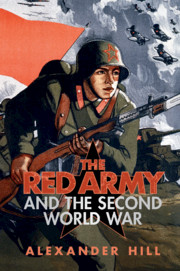Refine search
Actions for selected content:
15418 results in Military history
1 - Germanic Dreams
-
- Book:
- Building a Nazi Europe
- Published online:
- 02 March 2017
- Print publication:
- 26 January 2017, pp 26-51
-
- Chapter
- Export citation
Conclusion
-
- Book:
- Building a Nazi Europe
- Published online:
- 02 March 2017
- Print publication:
- 26 January 2017, pp 203-208
-
- Chapter
- Export citation
3 - Joining the Burgeoning Waffen-SS
-
- Book:
- Building a Nazi Europe
- Published online:
- 02 March 2017
- Print publication:
- 26 January 2017, pp 89-117
-
- Chapter
- Export citation
6 - The End of the Germanic Project
-
- Book:
- Building a Nazi Europe
- Published online:
- 02 March 2017
- Print publication:
- 26 January 2017, pp 175-202
-
- Chapter
- Export citation
Index
-
- Book:
- Building a Nazi Europe
- Published online:
- 02 March 2017
- Print publication:
- 26 January 2017, pp 225-237
-
- Chapter
- Export citation
Common Abbreviations and Foreign Terms
-
- Book:
- Building a Nazi Europe
- Published online:
- 02 March 2017
- Print publication:
- 26 January 2017, pp xv-xvi
-
- Chapter
- Export citation

The Red Army and the Second World War
-
- Published online:
- 21 January 2017
- Print publication:
- 24 December 2016

Insurgencies and Counterinsurgencies
- National Styles and Strategic Cultures
-
- Published online:
- 21 January 2017
- Print publication:
- 24 December 2016
2 - Reconsidering Desertion in Old-Regime Europe
-
- Book:
- Motivation in War
- Published online:
- 09 February 2017
- Print publication:
- 16 January 2017, pp 55-94
-
- Chapter
- Export citation
Acknowledgements
-
- Book:
- Motivation in War
- Published online:
- 09 February 2017
- Print publication:
- 16 January 2017, pp ix-xi
-
- Chapter
- Export citation
Abbreviations
-
- Book:
- Motivation in War
- Published online:
- 09 February 2017
- Print publication:
- 16 January 2017, pp xii-xii
-
- Chapter
- Export citation
4 - Why Did They Enlist?
-
- Book:
- Motivation in War
- Published online:
- 09 February 2017
- Print publication:
- 16 January 2017, pp 128-164
-
- Chapter
- Export citation
Dedication
-
- Book:
- Motivation in War
- Published online:
- 09 February 2017
- Print publication:
- 16 January 2017, pp vi-vi
-
- Chapter
- Export citation
Bibliography
-
- Book:
- Motivation in War
- Published online:
- 09 February 2017
- Print publication:
- 16 January 2017, pp 232-268
-
- Chapter
- Export citation
Introduction
-
- Book:
- Motivation in War
- Published online:
- 09 February 2017
- Print publication:
- 16 January 2017, pp 1-16
-
- Chapter
- Export citation
Copyright page
-
- Book:
- Motivation in War
- Published online:
- 09 February 2017
- Print publication:
- 16 January 2017, pp iv-iv
-
- Chapter
- Export citation
Figures and Tables
-
- Book:
- Motivation in War
- Published online:
- 09 February 2017
- Print publication:
- 16 January 2017, pp viii-viii
-
- Chapter
- Export citation
5 - A Counter-Culture of Honour
-
- Book:
- Motivation in War
- Published online:
- 09 February 2017
- Print publication:
- 16 January 2017, pp 165-194
-
- Chapter
- Export citation
3 - Discipline and Defiance
-
- Book:
- Motivation in War
- Published online:
- 09 February 2017
- Print publication:
- 16 January 2017, pp 95-127
-
- Chapter
- Export citation
Concluding Remarks
-
- Book:
- Motivation in War
- Published online:
- 09 February 2017
- Print publication:
- 16 January 2017, pp 226-231
-
- Chapter
- Export citation
